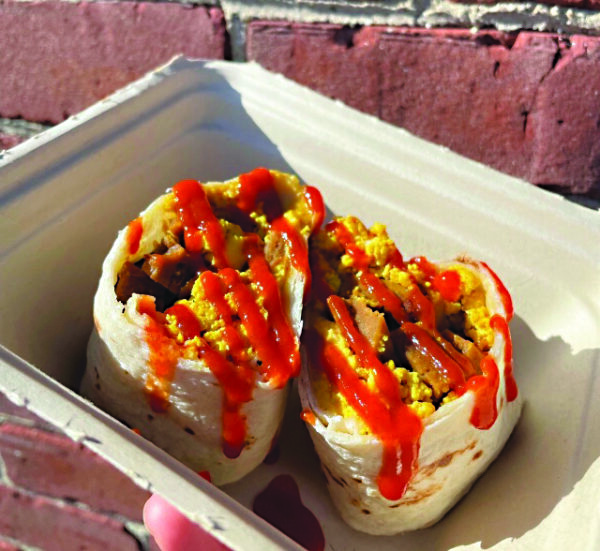Celebrate 2022 with a special meal or dining party
Ring in 2022 with a special multi-course meal, a midnight Champagne toast, or just a night out at one of these New Hampshire restaurants, bars and function centers open on New Year’s Eve, Friday, Dec. 31. A few local eateries are also open for brunch on either New Year’s Day, Saturday, Jan. 1, or the following morning on Sunday, Jan. 2. Did we miss any restaurants offering New Year’s specials? Let us know at [email protected].
• 815 Cocktails & Provisions (815 Elm St., Manchester, 782-8086, 815nh.com) will host a New Year’s Eve party on Friday, Dec. 31, at 9 p.m. Tickets are $150 and include drink and food specials, an open bar, an unlimited photo booth and a Champagne toast at midnight.
• 900 Degrees Neapolitan Pizzeria (50 Dow St., Manchester, 641-0900, 900degrees.com) will be open during its normal hours on Friday, Dec. 31, from 11:30 a.m. to 10 p.m.
• Alan’s of Boscawen (133 N. Main St., Boscawen, 753-6631, alansofboscawen.com) is holding a New Year’s Eve party on Friday, Dec. 31, featuring a buffet that will be served from 4 to 9 p.m., in addition to live music from Stray Dog. Tickets are $15.
• Auspicious Brew (1 Washington St., Suite 1103, Dover, 953-7240, auspiciousbrew.com) will hold a family-friendly New Year’s Eve party on Friday, Dec. 31, from 5:30 to 7:30 p.m. Food will be available from Dos Mexican Eats and classic and hard kombuchas will be on draft. Tickets are $10 and will also include house made hot cocoa, craft opportunities, a festive photo station and more.
• The Barley House Restaurant & Tavern (132 N. Main St., Concord, 228-6363, thebarleyhouse.com) will be open during its normal hours on Friday, Dec. 31, from noon to 10 p.m.
• Bedford Village Inn & Restaurant (2 Olde Bedford Way, Bedford, 472-2001, bedfordvillageinn.com) will serve a special four-course prix fixe dinner menu on Friday, Dec. 31, with seatings from 4 to 9 p.m. The menu will include your choice of an appetizer (Dunk’s mushroom toast, yellowfin tuna poke, a Vermont cheese board, New England oysters, butternut squash risotto or lobster bisque); a salad (watercress and firecracker mizuna or Boston bibb); an entree (grilled filet mignon, smoked New Bedford sea scallops, Moroccan-spiced Australian grass-fed lamb rack, pan-seared Faroe Island salmon, cornbread-crusted Icelandic cod loin, Robie Farm pork tenderloin or maple-roasted acorn squash); and a dessert (midnight chocolate cake, peach Champagne sorbet, Godiva creme brulee, pumpkin cheesecake or apple raisin strudel). The cost is $95 per person. The BVI’s Lobby Bar will also be open on Friday, Dec. 31, from 11:30 a.m. to 1 a.m. A special brunch will then be served on Saturday, Jan. 1, from 9 a.m. to 2 p.m. The Lobby Bar will also be open that day, from 8 to 10:30 a.m. for breakfast and from 4 to 9 p.m. for lunch.
• Belmont Hall & Restaurant (718 Grove St., Manchester, 625-8540, belmonthall.net) will be open on Friday, Dec. 31, until 2 p.m.
• Bistro 603 (345 Amherst St., Nashua, 722-6362, bistro603nashua.com) will be open on Friday, Dec. 31, from 11 a.m. to 2 a.m., and on Saturday, Jan. 1, from 10 a.m. to close (likely around 10 p.m. for the kitchen and 11 p.m. for the bar). On Friday, Bistro 603 will host a New Year’s Eve Bash, featuring live music by the Massive Groove Band beginning at 9:30 p.m., as well as a special features menu, a late night buffet, a midnight Champagne toast and more.
• Buckley’s Great Steaks (438 Daniel Webster Hwy., Merrimack, 424-0995, buckleysgreatsteaks.com) will be open on both Friday, Dec. 31, and Saturday, Jan. 1, from 4 to 9 p.m. each evening.
• Cask & Vine (1 E. Broadway, Derry, 965-3454, caskandvine.com) is celebrating nine years in business with its annual end-of-year anniversary party on Friday, Dec. 31, beginning at 5 p.m. They’re taking reservations now for $25 per person, which will be applied to your bill at the end of the evening, with a complimentary toast at midnight. Go to caskandvine.com/nye.
• Castleton Banquet and Conference Center (58 Enterprise Drive, Windham, 898-6300, castletonbcc.com) will host a special New Year’s Eve party on Friday, Dec. 31, from 7 to 10 p.m., featuring a three-course meal, an open bar, a 50/50 raffle, a Champagne toast at midnight and more. Tickets are $200 (event is 21+ only).
• CJ’s Great West Grill (782 S. Willow St., Manchester, 627-8600, cjsgreatwestgrill.com) will be open on Friday, Dec. 31, until 10 p.m.
• Colby Hill Inn (33 The Oaks, Henniker, 428-3281, colbyhillinn.com) will serve a special New Year’s Eve sparkling wine dinner on Friday, Dec. 31, from 7 to 10:30 p.m. The six-course prix fixe meal will feature pairings of Sea Smoke wines — courses will include foie gras torchon, New Hampshire oysters, petite rabbit and mushroom cassoulet, petite tournedos with lobster tail, a white winter festival dessert featuring a coconut cup, white chocolate gelato and crisp meringue, and a plate of mignardises. The cost is $150 per person. Overnight packages at the Inn are also available, which will include a complimentary Champagne brunch and late night treats, as well as a late 1 p.m. checkout the next day.
• Copper Door Restaurant (15 Leavy Drive, Bedford, 488-2677; 41 S. Broadway, Salem, 458-2033; copperdoor.com) will serve a special New Year’s Eve prix fixe dinner menu on Friday, Dec. 31, from 4 to 8 p.m. at both locations, featuring meals of two, three or four courses. Options include sesame tuna risotto, crispy pork and beef meatballs, fish chowder, sausage and kale soup, shaved Brussels sprout and arugula, grilled filet oscar, braised short rib, soy honey glazed salmon, seafood-stuffed haddock, truffled mushroom ravioli, duck confit risotto, sugar cookie cupcakes, German chocolate cake, and vanilla Funfetti cheesecake. The cost is $69 for a two-course meal, $79 for a three-course meal and $89 for a four-course meal. Reservations are highly recommended. The Copper Door’s regular menus will also be available from 11:30 a.m. to 4 p.m. at both locations. Live music will be featured from 6 to 9 p.m.
• Copper Kettle To Go (39 Main St., Wilton, 654-2631, copperkettletogo.com) will serve a special New Year’s Eve buffet dinner on Friday, Dec. 31, at 8 p.m., featuring a dip station with Buffalo chicken, spinach and onion dips, as well as other items like crab rangoons, egg rolls, macaroni and cheese, butternut squash ravioli and more. Tickets are $40 per person and also include a Champagne toast at midnight.
• CR’s The Restaurant (287 Exeter Road, Hampton, 929-7972, crstherestaurant.com) will be open on Friday, Dec. 31, from 11:30 a.m. to 3 p.m. for lunch and from 5 to 9:30 p.m. for dinner.
• The Crown Tavern (99 Hanover St., Manchester, 218-3132, thecrownonhanover.com) will be open on Saturday, Jan. 1, from 4 to 9 p.m. Reservations are recommended.
• Epoch Gastropub (The Exeter Inn, 90 Front St., Exeter, 778-3762, epochrestaurant.com) will be open on Friday, Dec. 31, from 3 to 9 p.m., serving a special New Year’s Eve prix fixe menu alongside its normal menu. The meal will include your choice of a first course (grilled local oysters or red beet salad), an entree (braised short rib, pan-seared salmon or beet rissoles), and a dessert (citrus creme brulee with fresh oranges, or dark chocolate mousse with candied walnuts and coffee ice cream). The cost is $55 per person.
• Fire and Spice Bistro (70 Route 108, Newfields, 418-7121, fireandspicebistro.com) will be open on Friday, Dec. 31, serving dinner from 4 to 10 p.m. Local acoustic guitarist Chris O’Neill will perform live from 5 to 10 p.m., and the bar will remain open until 12:30 a.m.
• Firefly American Bistro & Bar (22 Concord St., Manchester, 935-9740, fireflynh.com) will be open on Friday, Dec. 31, from 11 a.m. to 10 p.m. On Saturday, Jan. 1, Firefly will be open from 10 a.m. to 3 p.m. for brunch and from 4 to 9 p.m. for dinner.
• The Foundry Restaurant (50 Commercial St., Manchester, 836-1925, foundrynh.com) will be open on Friday, Dec. 31, from 4 to 9 p.m., and for brunch on Saturday, Jan. 1, from 10 a.m. to 3 p.m., featuring an all-you-can-eat buffet for $35 with prime rib, a build-your-own waffle bar, $5 mimosas, live music and more.
• Granite Restaurant & Bar (The Centennial Hotel, 96 Pleasant St., Concord, 227-9005, graniterestaurant.com) will be open during its normal hours on Friday, Dec. 31, from 5 to 9 p.m.
• LaBelle Winery Derry (14 Route 111, Derry, 672-9898, labellewinery.com) will hold a special three-course plated dinner and celebration for New Year’s Eve on Friday, Dec. 31, from 6 to 10:30 p.m. Seatings will take place in the vineyard ballroom, adjacent to Americus Restaurant, and the evening will also feature a live performance by the Freese Brothers Big Band and a stroll through LaBelle Lights. The meal will feature house-made pork dumplings, a baby kale salad with pomegranate seeds, blue cheese, roasted cashews and a winter citrus vinaigrette, a surf and turf entree of hoisin-glazed short rib and yuzu-glazed shrimp with baby bok choy and sticky rice cakes, and chocolate pot creme for dessert along with fortune cookies. The cost is $100 per person and includes the dinner, a greeting wine pass, access to a cash bar, and admission to LaBelle Lights after the live performance.
• Mile Away Restaurant (52 Federal Hill Road, Milford, 673-3904, mileawayrestaurantnh.com) will serve a multi-course meal for New Year’s Eve on Friday, Dec. 31, featuring your choice of an entree (sliced roasted tenderloin of beef, duck Grand Marnier, nut-crusted chicken, chicken piccata, pork forestiere, schweineschnitzel, roasted vegetable lasagna, baked stuffed Jumbo shrimp, baked stuffed scrod or maple-glazed salmon); and a dessert (chocolate mousse cake, flourless chocolate cake, bourbon bread pudding, cheesecake, lemon mascarpone cake, or sorbet). All dinners come with appetizers like tomato bisque, Swedish meatballs and a fresh fruit plate with sorbet (or you can substitute shrimp cocktail, escargots and onion soup gratinee), and a Caesar or garden salad. Entrees also include your choice of a baked potato, Swiss potato or rice pilaf, and your choice of butternut squash, pickled beets or applesauce.
• MT’s Local Kitchen & Wine Bar (212 Main St., Nashua, 595-9334, mtslocal.com) will be open on both Friday, Dec. 31, and Saturday, Jan. 1, from 4 to 9 p.m. each evening.
• New England’s Tap House Grille (1292 Hooksett Road, Hooksett, 782-5137, taphousenh.com) will hold a special New Year’s Sunday brunch on Sunday, Jan. 2, from 9 a.m. to 1 p.m., featuring a prime rib and turkey carving station, build-your-own omelets and crepes, a raw bar, and a bloody mary and mimosa bar. The cost is $29 for adults and $14.95 for kids.
• Osteria Poggio (18 Main St., Center Harbor, 250-8007, osteriapoggio.com) will host a special New Year’s Eve gala on Friday, Dec. 31, at 7 p.m., featuring passed appetizers, Prohibition-style cocktails, music, dancing, a photo booth and prosecco toast. Tickets are $40 per person.
• Piccola Italia Ristorante (815 Elm St., Manchester, 606-5100, piccolaitalianh.com) will be open on Friday, Dec. 31, from 4 to 10 p.m., and on Saturday, Jan. 1, from 4 to 9 p.m.
• Raleigh Wine Bar + Eatery (67 State St., Portsmouth, 427-8459, raleighwinebar.com) will serve a special four-course New Year’s Eve dinner on Friday, Dec. 31, with optional wine pairings. Two seatings are available, at 6 p.m. and 8:30 p.m. Featured items to choose from will include endive salad, elk tartare, roasted squash, coal-roasted quail, root vegetable gratin, magret duck breast, coal-roasted sea bass, chocolate cake, and crème fraîche cake with pistachio praline. The cost is $120 per person with Champagne toast (additional $45 if wine pairings are included). Reservations require a $25 deposit per person.
• The Red Blazer Restaurant & Pub (72 Manchester St., Concord, 224-4101, theredblazer.com) will be open on Friday, Dec. 31, until 7 p.m.
• Saddle Up Saloon (92 Route 125, Kingston, 347-1313, saddleupsaloonnh.com) will host a special New Year’s Eve party on Friday, Dec. 31. Dinner will be served at 7 p.m., featuring your choice of prime rib, half-roasted chicken or baked haddock (each entree also comes with mashed potatoes and veggies). Local cover band Bite the Bullet will then perform from 8:30 p.m. to 12:30 a.m. The cost is $50 per person and also includes a Champagne toast at midnight, followed by a pizza buffet.
• The Shaskeen Irish Pub and Restaurant (909 Elm St., Manchester, 625-0246, shaskeenirishpub.com) will host a special New Year’s Eve party on Friday, Dec. 31, featuring a buffet from 8 to 10 p.m., a midnight Champagne toast, and music by Chris Bennett, a.k.a. DJ Myth. The cost is $50 per person.
• Stalk Restaurant (286 Central Ave., Dover, 343-2600, stalkrestaurant.com) will host a special five-course prix fixe menu for New Year’s Eve on Friday, Dec. 31, with two seatings available (5 to 5:30 p.m. for the first seating and 7:45 to 8:15 p.m. for the second seating) with two and a half hours allotted per reservation. A variety of items will be available to choose from, like pan-seared scallop, red beet salad, Atlantic cod chowder, udon noodles, duck confit ravioli, pinot-braised short rib and more. The cost is $85 per person and includes complimentary prosecco. Wine pairings and cocktails are also available at an additional cost.
• Surf Restaurant (207 Main St., Nashua, 595-9293; 99 Bow St., Portsmouth, 334-9855; surfseafood.com) will be open on Friday, Dec. 31, and Saturday, Jan. 1, from 4 to 9 p.m. both evenings, at its Nashua location. Its Portsmouth location will be open on Friday, Dec. 31, from 11 a.m. to 9 p.m., and on Saturday, Jan. 1, from 3 to 9 p.m.
• T-Bones Great American Eatery (25 S. River Road, Bedford, 641-6100; 404 S. Main St., Concord, 715-1999; 39 Crystal Ave., Derry, 434-3200; 77 Lowell Road, Hudson, 882-6677; 1182 Union Ave., Laconia, 528-7800; 311 S. Broadway, Salem, 893-3444; t-bones.com) will be open on Friday, Dec. 31, until 10 p.m., at all of its locations.
• The Wild Rose Restaurant (Stonehurst Manor, 3351 White Mountain Hwy., North Conway, 356-3113, thewildroserestaurant.com) will serve a special New Year’s Eve dinner menu on Friday, Dec. 31, with seatings at 6 p.m. and 9 p.m. The meal includes your choice of an appetizer (bacon-wrapped scallops, shrimp cocktail, Jonah crab cakes, forest mushroom pot sticker, or crab and lobster bisque); a Caesar salad; your choice of an entree (pit smoked and aged prime rib of beef, lobster ravioli, filet of cod with a lobster cream sauce, grilled New York strip steak, crispy half-roasted duck, shrimp, scallops, lobster and Jonah crab meat in a garlic basil Parmesan cream sauce, or grilled rack of Australian lamb); and a dessert (blueberry cheesecake, flourless double dark chocolate torte, limoncello cake or vanilla creme brulee). The cost is $78 per person and also includes signature sourdough bread, a seasonal vegetable, and coffee and tea.
• XO Bistro on Elm (827 Elm St., Manchester, 560-7998, xobistronh.com) will be open during its normal hours on Friday, Dec. 31, from noon to 10 p.m. They’ll also be open on Saturday, Jan. 1, from 4 to 10 p.m.
• Ya Mas Greek Taverna & Bar (125 Bridge St., Pelham, 635-4230, yamasgreektaverna.com) is throwing a special New Year’s Eve dinner party just down the street at Chunky’s Cinema Pub (150 Bridge St.), alongside a screening of the 2013 film The Great Gatsby, scheduled for Friday, Dec. 31, at 9 p.m. The evening will include a five-course menu, followed by a Champagne toast and a big-screen viewing of the Times Square ball drop at midnight. The cost is $90 per person and includes the dinner, the movie and the toast (optional wine pairings are also available at an additional cost).
• Zachary’s Chop House (4 Cobbetts Pond Road, Windham, 890-5555, zacharyschophouse.com) will be open on Friday, Dec. 31, from 11 a.m. to 9:30 p.m.
Featured photo: Courtesy photo.








